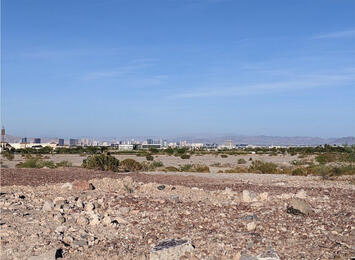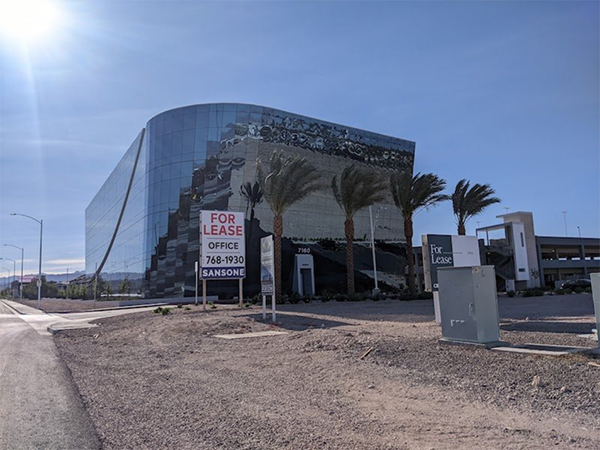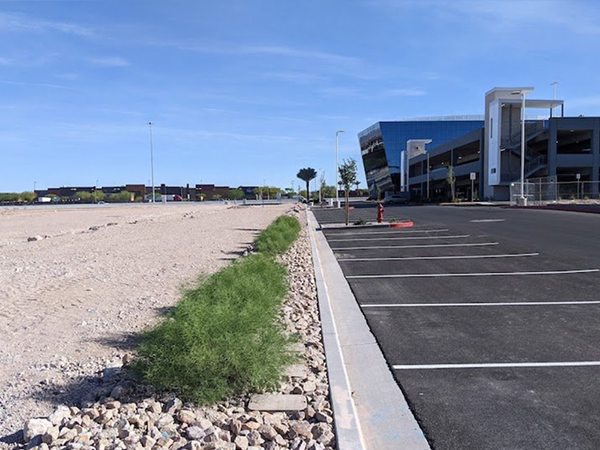
I hear a great deal about sustainability in the built environment that sounds both encouraging and delusional. These messages come from well intentioned environmentalists as well as corporate marketing departments. The general tone of the conversation is similar either way. Everyone can continue to live the way we do now, but by making a few minor adjustments we’ll transition away from coal, oil, and natural gas to benign materials and clean renewable energy. This transition will save households money, preserve nature, and be profitable for private enterprise. Along the way we’ll hardly even notice the difference. I make a point of exploring anything that purports to be “green” to see if it passes the smell test.
Las Vegas is a great place to poke around and examine these themes. This part of Nevada receives 4 inches (10 cm) of rain per year. To put that into perspective, the national average is 38 inches (96 cm.)
The dominant soil is a sedimentary rock that’s a combination of heavy clay, gravel, sand and calcium carbonate called hardpan or caliche. It’s basically a naturally occurring form of concrete and quite possibly the worst material you could imagine if you were interested in growing anything.
The high temperature in Las Vegas is 125 F (51 C) and the low is 8 degrees (– 13 C). Without modern machinery and a national network keeping this place supplied with essentials there’s no way the current population of 2,200,000 people could survive in this environment. Las Vegas is basically a space colony.
Before my trip to Vegas I did some research and made a short list of award winning buildings to visit. This newly constructed suburban office park is one of them. Axiom is a Class A property and sports a LEED certification from the Green Building Council. It’s the first phase of a larger commercial development on this site.

First off, it’s a glass box in a desert. If you’ve ever left your car out in the sun on a hot summer day you know what happens. You can bake a potato in the glove box. Combine this with the fact that the building is surrounded by black asphalt paving and concrete. They soak up heat all day long then radiate it back out into the night. If you were trying to design a structure that maximized the worst aspects of the extreme climate this is exactly how you’d do it.

Of course, specialty glass is used in these buildings to keep the heat out and prevent the worst aspects of the greenhouse effect. And there are little gestures of drought tolerant native plantings on the edge of the pavement along with the rainwater catchment swales behind the multistory parking garage. These are the elements that add up to the environmental certifications. Look! LED lights! An Energy Star rated industrial air conditioning compressor!
None of this factors in the energy and pollution associated with manufacturing and transporting this amount of steel, glass, and concrete. Notice how the garage is larger than the office building itself. All the green credentials in the world won’t change the fact that everyday hundreds of cars will drive to and from this place for decades because it’s in a far flung location.
Is this building more efficient than a similar one built twenty or thirty years ago? Yes. As Las Vegas continues to grow and builds many more such places farther and farther out in the desert does it really matter? Shrug.
Read the rest of this piece at Granola Shotgun.
Johnny Sanphillippo is an amateur architecture buff with a passionate interest in where and how we all live and occupy the landscape, from small rural towns to skyscrapers and everything in between. He travels often, conducts interviews with people of interest, and gathers photos and video of places worth talking about (which he often shares on Strong Towns). Johnny writes for Strong Towns, and his blog, Granola Shotgun.
Photos: by the author, courtesy Granola Shotgun












